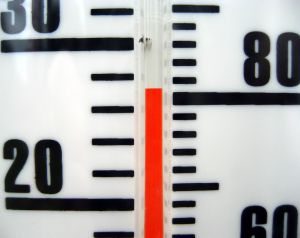Heaven knows the competition is stiff: every day throws up extraordinary claims by any number of columnists in the Murdoch media. But we think we have found what could be the dumbest thing ever written by a Murdoch employee on climate change.
It’s by Miranda Devine, the columnist who once wrote for Fairfax and now graces the pages of the Daily Telegraph in Sydney. I was skimming through it in the local cafe this morning and came across her article: “Calm down, everyone. It’s hot, not the Armageddon.”
 The basis for Devine’s article was that the recent heatwave – which the Bureau of Meteorology describes as record breaking, and included a record 46.9°C high for Penrith in Sydney’s west – was just another hot summer.
The basis for Devine’s article was that the recent heatwave – which the Bureau of Meteorology describes as record breaking, and included a record 46.9°C high for Penrith in Sydney’s west – was just another hot summer.
Proof? Why, in 1837, Sydney had recorded temperatures of 54°C, Devine claimed.
“Take March 18, 1832, which The Sydney Gazette reported as “insufferably warm”,” Devine wrote. She then went on to quote that newspaper: “At 1pm, the thermometer was 54°C in the sun. The cattle suffered much. Working bullocks dropped dead.”
Now, how to explain this. As most 6-year-olds might understand, when you take a temperature reading, you do it in the shade, not in the sun.
Google “how to take a temperature reading” and you come up with: “When you are measuring the air temperature, be sure to have the thermometer in the shade. If the sun shines on the thermometer, it heats the liquid. Then the reading is higher than the true air temperature.”
Australia’s BoM makes the same point, noting that it monitors temperatures in a louvre box known as the “Stevenson” screen.
Just as an experiment, the air temperature where I am writing this article is 28°C. So I took the thermometer out to the sun. Even with the clouds, it rose to 36°C. When the clouds parted, it quickly jumped to more than 50°C before I brought it back inside.
So yes, the thermometer may have been showing 56°C in the sun in Sydney on that day in 1832 and maybe a million times since in thousands of different places.
One of Devine’s own readers claimed it was 68°C on the court at the Australian Open this year. Perhaps it was. But that’s in the sun. It wasn’t Melbourne’s official temperature that day.
 It’s why on hot days you can fry an egg on a road or a car bonnet exposed to the sun. Try doing it inside on the dining table; it may not work so well.
It’s why on hot days you can fry an egg on a road or a car bonnet exposed to the sun. Try doing it inside on the dining table; it may not work so well.
And that’s probably why newspaper offices have a roof. Chances are that if you leave a journalist out in the sun too long, they might end up writing silly things about climate change.
(PS. We wonder if the quote from the Sydney Gazette is truly accurate. Celsius was only widely used in Australia from the 1970s with the introduction of metrication.
Indeed, it turns out Devine can’t even cut and paste properly. Rather than “working bullocks dropped dead”, there was just one.
“The cattle suffered much. A working bullock dropped down dead on the road, and another fell down, but the owner immediately covered him over with wet clay, and in the course of three hours he recovered.”
A BoM spokesman told RenewEconomy that official record began in Australian in 1910, but even the papers of the day in the 1800s warned about reported temperature observations, noting they could not be verified and often thermometers were left hanging in the sun or on a verandah.
Indeed, the BoM gives a whole explanation about pre-1900 temperature readings, including this observation:
“Unfortunately for modern-day scientists, there was no common standard for observing equipment during the colonial period. Any number of instrument configurations were used, including—perhaps iconically—thermometers housed in beer crates on outback verandas.”









